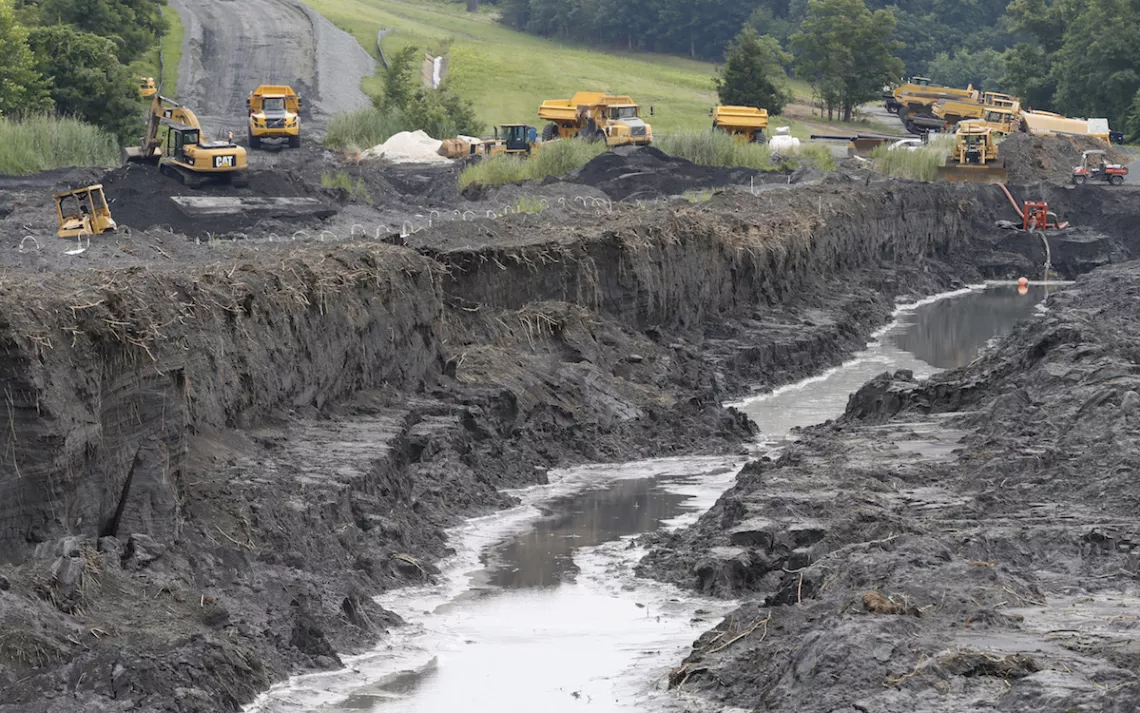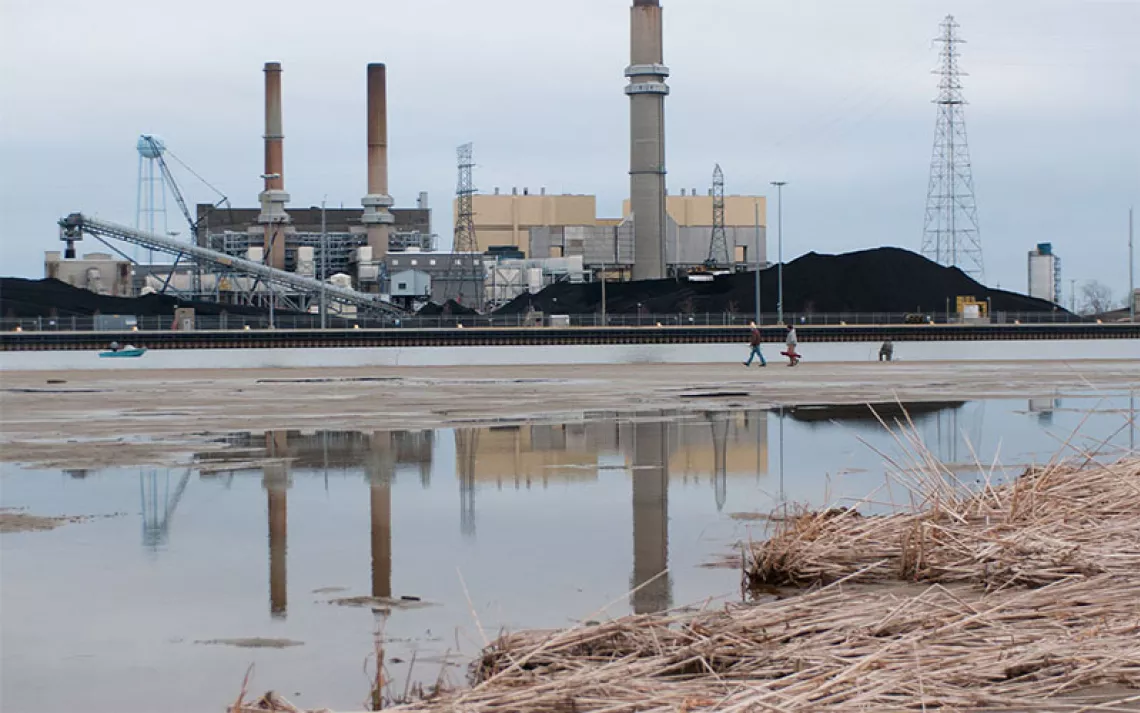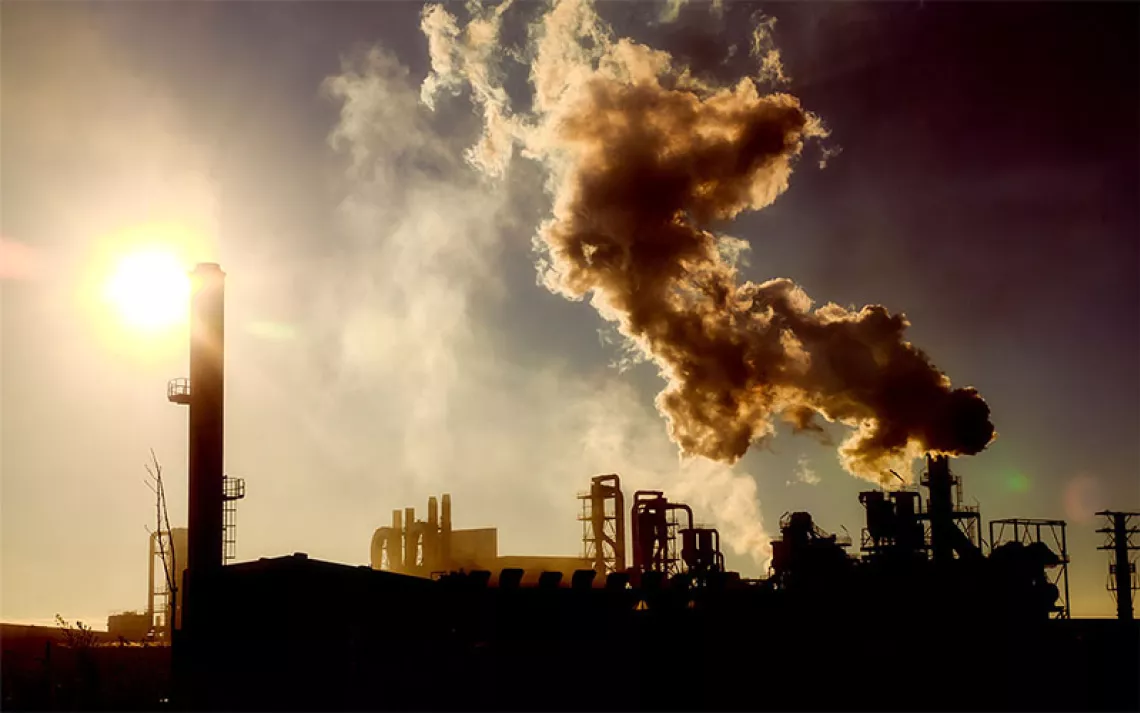Coal-Ash Chemicals in Your Drinking Water: Y/N?
Pruitt’s EPA wants to turn authority to not do anything back to the states

Trucks haul coal ash from a retention pond to a permanent pond at Dominion Power's Possum Point Power Station in Dumfries, VA | Photo by AP Photo/Steve Helber
Last week Deborah Graham and her husband celebrated an odd anniversary—three years since they got a letter telling them not to drink water from their Salisbury, North Carolina, well. Dozens of their neighbors got similar notices, as did hundreds of households across the state. So the Grahams started drinking bottled water and marking the days, now at 1,100 and counting.
The Grahams live within a thousand feet of a pit holding waste from a coal-fired power plant (it converted to gas in 2013). Their water was polluted with vanadium and hexavalent chromium, two chemicals found in coal combustion residuals (CCRs)—also known as coal ash, what remains after coal is burned.
The EPA lists 21 potential contaminants from coal ash or its leachate, including arsenic, boron, cadmium, lead, and mercury. According to the Environmental Integrity Project, a D.C.-based environmental watchdog organization, the United States’ 400 or so coal-fired power plants produce nearly a third of the industrial pollution discharged into rivers and streams nationally. Although dry coal ash can be dug out and dumped in mountain-size landfills, more commonly it’s washed from the plant as slurry into a settling pond—a pit, lagoon, or impoundment dug into the ground. Some ponds rest directly on water tables; others rise above the landscape, encircled by earthen dams. Once ponds fill up, effluent is discharged, often to the same lake or stream that cools the plant.
According to Lisa Evans, senior counsel at Earthjustice, 90 percent of ash ponds are unlined, making them the most dangerous way to dispose of coal ash. Every single coal-ash lagoon in the Southeast, says Frank Holleman, senior attorney at the Southern Environmental Law Center, is leaking and polluting.
Interest groups and the EPA spent eight years hashing out the details of what’s known as the 2015 CCR Rule, which provided some guidance on what to do with 130 million tons of coal ash produced each year in the United States, plus the ash sitting in some 1,400 landfills and ponds. While the rule did set national standards for protecting groundwater, environmentalists considered it far from ideal. (A key failing was the EPA’s determination that coal ash is solid waste, like household garbage, not hazardous waste.) The rule set design specs, such as linings for ash ponds, and required leaking, unlined ponds to close. It mandated that groundwater tables and wetlands be considered when siting landfills and ponds, required inspections, and addressed the structural integrity of impoundment dams. It also obligated owner/operators to monitor groundwater for specific potential pollutants (industry calls these “constituents”) and post data on a publicly accessible website.
Now the Trump administration is seeking to weaken these hard-won protections. On March 1, the EPA proposed amending the Obama-era CCR Rule—the first national legislation regulating waste from coal-fired electric power plants—with a deadline for comments coming up on April 30. Environmental groups fear the new amendments will gut the 2015 rule’s protections and turn authority over to states and power producers. Industry representatives welcome the prospect of local authorities having more say over groundwater standards near coal-ash disposal sites.
Changes proposed by Scott Pruitt’s EPA center around “flexibilities” and “alternative strategies.” These would allow, for example, coal ash itself to be used in building up the sides of the impoundments as they’re being closed and would shorten the current 30-year period for site monitoring after closure.
Perhaps most importantly, while the current rule specifies the use of background concentrations to determine appropriate groundwater protection standards, the revision would leave the determination up to individual state agency directors. States could decide when cleanups are necessary and suspend groundwater monitoring requirements if the power producer convinces them that there’s no chance of toxins migrating to groundwater.
Lisa Hallowell, senior attorney at the Environmental Integrity Project, is concerned. Under the current system, she says, arsenic found in groundwater above the health-based minimum contaminant level would trigger a cleanup. But the new rule would allow a state director to decide that cleanup isn’t necessary. “That so-called flexibility,” Hallowell says, “would really not be able to ensure the health of people and the environment.”
Some of the EPA’s changes address issues brought up in court and by a 2016 petition filed by the Utility Solid Waste Activities Group, which represents coal-fired power plants. The group’s executive director, James Roewer, says these flexibilities allow for tailoring of standards to reflect local conditions. “States made it clear,” Roewer says, “that they wanted to have the authority, that they were in the best position to ensure groundwater and surface water are protected.”
But are state agencies up to the task? “This proposal would allow the utilities and compliance agencies to make up more lenient standards and require less—or no—actual cleanup of this illegal pollution,” says Nick Torrey, an attorney at the Southern Environmental Law Center. “All too often, state agencies are underfunded or too much under the sway of these powerful monopolies in these states.”
Most states don’t have a comprehensive set of coal-ash rules, according to Holleman, also of the law center. States could address many of these problems, he says, if they would enforce their antipollution laws and the federal Clean Water Act. “But they have not done it, and they will not do it.”
Holleman believes a national law that provides clear, specific standards actually helps state agencies enforce the law against the politically powerful utilities with politically powerful friends: “It’s an advantage to state agencies to be able to say, ‘We’re just following the national rule.’”
Amy Brown and her son sitting on their front porch with stacks of bottled water behind them | Photo courtesy of Progress, NC
The EPA released its proposal to amend the rule the day before utilities were required to post their monitoring data. Holleman says it’s not a coincidence. “There’s an ongoing battle by coal-fired utilities to use their influence with the new national EPA leadership to undercut the rights of citizens to protect their communities from the pollution of coal-ash sites.” The posting of groundwater contamination data is beginning to have real impact, he says, because it alerts communities and ratepayers to what’s happening in their neighborhoods.
Evans from Earthjustice says she finds it outrageous that the EPA would release its proposal before considering the new data."We’ve looked at the data,” Evans says, “and almost every coal-ash dump is leaking contamination into groundwater above health standards."
One small point of agreement between environmental and industry groups may be the EPA’s addition of boron to the list of contaminants that trigger more monitoring and cleanup. Boron is considered to be a warning flag of further pollution; its soluble form leaches from coal ash within 15 minutes of contact and travels to ground- and surface waters faster than other constituents, threatening aquatic life and drinking water.
That change could matter to people like Deborah Graham, as she starts day 1,101 of drinking bottled water. “Who will protect us,” she wonders, “if the EPA won’t?”
Through April 30, 2018, the EPA will be accepting written comments. You can post yours here.
 The Magazine of The Sierra Club
The Magazine of The Sierra Club



